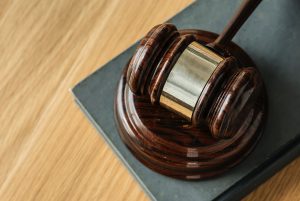In this patent infringement action, the plaintiff, Stuebing Automatic Machine Co. (“Stuebing”) filed a motion for violation of multiple discovery orders against the defendant. As part of the motion, Stuebing sought issue sanctions, including to have certain sales information deemed established.
 Stuebing had previously served multiple discovery requests, including interrogatories and document requests. Over a year after responses to the discovery requests were due, the district court ordered the defendant to fully respond to the requests in several different court orders. Despite these orders, the defendant provided Stuebing with incomplete discovery information.
Stuebing had previously served multiple discovery requests, including interrogatories and document requests. Over a year after responses to the discovery requests were due, the district court ordered the defendant to fully respond to the requests in several different court orders. Despite these orders, the defendant provided Stuebing with incomplete discovery information.
In analyzing the motion, the district court explained that “[a] party becomes vulnerable to sanctions upon the party’s failure to comply with a court’s discovery order. See U.S. v. $49,000 Currency, 330 F.3d 371, 379 (5th Cir. 2003). “A court has broad discretion to determine an appropriate sanction under [Federal Rule of Civil Procedure (hereafter “FRCP”)] 37(b), […] which may include an order directing that certain designated facts be taken as true.” Bradt v. Corriette, No. 16-CV-805-LY, 2018 WL 1866112, at *2 (W.D. Tex. April 18, 2018) (citing Pressey v. Patterson, 898 F.2d 1018, 1021 (5th Cir. 1990)). FRCP 37(b)(2) authorizes the imposition of a “concurrent sanction of reasonable expenses, including attorney’s fees, caused by the failure obey a discovery order.” Smith & Fuller, P.A. v. Cooper Tire & Rubber Co., 685 F.3d 486, 488 (5th Cir. 2012).”
 Patent Lawyer Blog
Patent Lawyer Blog


 As explained by the district court, Bayer asserted that the license resulting from the hypothetical negotiation would be a non-exclusive, running royalty license between competitors, and of Dr. Rausser’s four selected licenses, only one was a non-exclusive license, two were between competitors, and none of them used a running royalty.
As explained by the district court, Bayer asserted that the license resulting from the hypothetical negotiation would be a non-exclusive, running royalty license between competitors, and of Dr. Rausser’s four selected licenses, only one was a non-exclusive license, two were between competitors, and none of them used a running royalty. In the ongoing litigation war between Qualcomm and Apple, spanning multiple forums around the country, Qualcomm moved to exclude Apple’s technical experts’ reliance on certain license agreements by asserting that the agreement involved technology that was not sufficiently comparable. After reviewing the license agreements, the experts’ opinions, and the law, the district court concluded that Qualcomm’s motion should be granted.
In the ongoing litigation war between Qualcomm and Apple, spanning multiple forums around the country, Qualcomm moved to exclude Apple’s technical experts’ reliance on certain license agreements by asserting that the agreement involved technology that was not sufficiently comparable. After reviewing the license agreements, the experts’ opinions, and the law, the district court concluded that Qualcomm’s motion should be granted. patents at issue here. The Federal Circuit has cautioned “that ‘district courts performing reasonable royalty calculations [must] exercise vigilance when considering past licenses to technologies other than the patent in suit,’ and ‘must account for differences in the technologies and economic circumstances of the contracting parties[.]’” VirnetX, Inc. v. Cisco Systems, Inc., 767 F.3d 1308, 1330 (Fed. Cir. 2014) (citations omitted). “When relying on licenses to prove a reasonable royalty, alleging a loose or vague comparability between different technologies or licenses does not suffice.” LaserDynamics, Inc. v. Quanta Computer, Inc., 694 F.3d 51, 79 (Fed. Cir. 2012).
patents at issue here. The Federal Circuit has cautioned “that ‘district courts performing reasonable royalty calculations [must] exercise vigilance when considering past licenses to technologies other than the patent in suit,’ and ‘must account for differences in the technologies and economic circumstances of the contracting parties[.]’” VirnetX, Inc. v. Cisco Systems, Inc., 767 F.3d 1308, 1330 (Fed. Cir. 2014) (citations omitted). “When relying on licenses to prove a reasonable royalty, alleging a loose or vague comparability between different technologies or licenses does not suffice.” LaserDynamics, Inc. v. Quanta Computer, Inc., 694 F.3d 51, 79 (Fed. Cir. 2012). In a patent infringement action, Takeda Pharmaceuticals America, Inc., and Takeda Pharmaceuticals U.S.A., Inc.’s (collectively, “Takeda”) filed a motion to disqualify Baker Botts, L.L.P. (“Baker Botts”) from representing Defendants Zydus Pharmaceuticals (USA) Inc. and Cadila Healthcare Limited (collectively, “Zydus”). Takeda moved to disqualify Baker Botts from representing Zydus based on Baker Botts’ alleged previous representation of Ethypharm S.A. (“Ethypharm”) in earlier litigation involving Takeda’s Prevacid® SolutabTM product.
In a patent infringement action, Takeda Pharmaceuticals America, Inc., and Takeda Pharmaceuticals U.S.A., Inc.’s (collectively, “Takeda”) filed a motion to disqualify Baker Botts, L.L.P. (“Baker Botts”) from representing Defendants Zydus Pharmaceuticals (USA) Inc. and Cadila Healthcare Limited (collectively, “Zydus”). Takeda moved to disqualify Baker Botts from representing Zydus based on Baker Botts’ alleged previous representation of Ethypharm S.A. (“Ethypharm”) in earlier litigation involving Takeda’s Prevacid® SolutabTM product.
 In this patent infringement action, the plaintiff, Whirlpool Properties (“Whirlpool”) noticed several depositions of third-party witnesses near the discovery cut-off. The defendant, Filters Fast, moved for an order to stop the depositions.
In this patent infringement action, the plaintiff, Whirlpool Properties (“Whirlpool”) noticed several depositions of third-party witnesses near the discovery cut-off. The defendant, Filters Fast, moved for an order to stop the depositions.